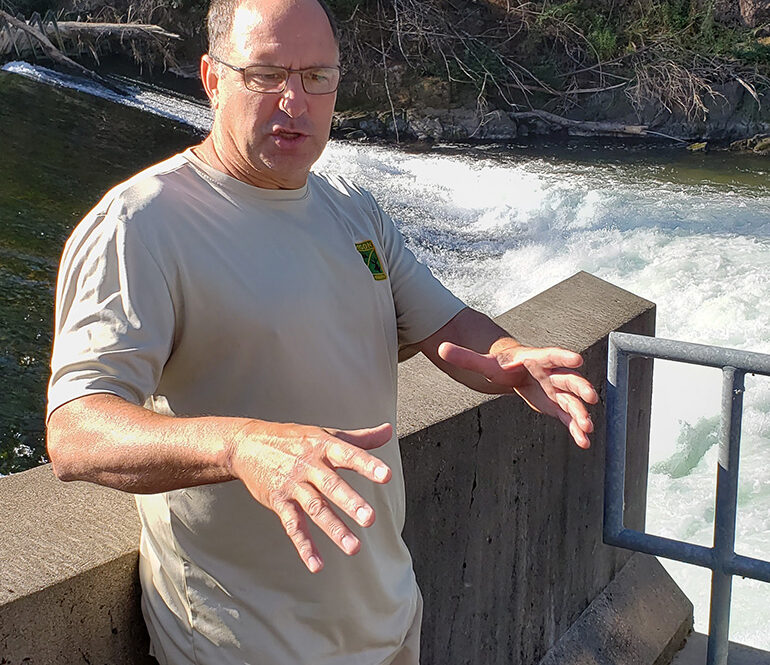This year’s run at the Minto fish hatchery is on a record pace, with 6,500 salmon and other fish counted by Oregon Department of Fish and Wildlife officials through Aug. 23.
One after another, fish encountered the North Santiam River water barrier, turned left and scrambled up the 52, 10-inch fish ladders and into a chute for sorting. Some salmon ultimately will head up river to the Marion Forks hatchery 60 fish at a time in a tanker truck. Others will spawn at Minto, and their offspring will be incubated and reared at Marion Forks “because the cold, clear water up there mimics what was there before the dams,” said Minto manager Greg Grenbemer.
“Then, we’ll bring ’em back here, acclimate them for a year, and then let ’em go… and they’ll head toward Alaska.”
It’s a finely tuned scientific process, with clipped fins, coded wire tags and information such as gender and length all carefully recorded. The current Minto operation is far more expansive and automated than its predecessor, which was replaced in 2013 after a 2008 biological opinion noted the negative impact of the Detroit and Big Cliff dams on the health of the salmon and steelhead runs.
A bank of massive pumps takes care of cleaning the screens where the fish enter. Grenbemer and his staff used to maintain them by hand. Radar and sonar are part of an automated valve system that Grenbemer jokingly says “scares me to death.”A crane and hopper contraption rated at 7.5 tons pulls brood salmon out of the holding ponds and loads them into the tanker truck without human hands ever touching the fish.
“How do we get these fish back there and how do we provide a good environment upstream and downstream?” said Grenbemer, who has been working the North Santiam spawning grounds for more than 30 years, with the first 20 or so at Marion Forks.
“Sometimes I feel like a dad and sometimes I feel like a fish,” he said.
How do the fish feel? That’s an easy construct to appreciate when you watch 30 pounds or so of salmon careen down a chute like a kid at a water park before being expertly sorted by Grenbemer and his technician, Tyler Starkey.
The thrill ride finale comes at the conclusion of an incredible journey. North Santiam salmon live most of their lives in an oceanic environment and then switch back to fresh water at Astoria for the trip up the Columbia and up the Willamette and up the Santiam to their North Santiam spawning grounds.
Some of them arrive looking a bit worse for wear because of weight loss or sea lion scratches or parasites in their gills, but Grenbemer says that “they have to be in pretty good shape to get all the way up here.”
And every fish is an individual. When asked how long it takes for a salmon to make the run from Astoria to Minto, Grenbemer just shrugs.
“Some do it in seven to ten days, some do it in two-and-a-half months,” he said. “It depends on water flows, temperature and what kind of fish they are.”
It’s the same mixed bag for young smolts when they head back for Astoria. Some will get to Oregon City on the Willamette in five or six days, Grenbemer said, with others moseying around, despite having the current behind
them, for a month or so.
The hatchery, like many other Santiam Canyon landmarks, faced a trial by fire on Labor Day weekend in 2020, and it has the scars to prove it.
The Beachie Creek Fire roared down the canyon, took out most of the trees that surrounded the hatchery, leveled its maintenance building and a couple of trucks and melted pieces of plastic and aluminum into the hatchery’s
concrete pad.
But the concrete didn’t burn, Grenbemer kept water flowing through the system to keep things from overheating, and the complex’s generator survived despite the front door being melted shut. And they didn’t lose a single fish.
“The fire happened at the worst time,” Grenbemer said. “We were one day away from spawning. We would have lost the entire run. This facility was designed to get fish in quickly but not to get them out quickly. That was damn scary.”
The effort to keep the hatchery going was immortalized in a video that shows masked crews harvesting the eggs of the female salmon amid a blanket-like yellowish haze. See www.youtube.com/watch?v=jhgrIvpJues for the video.
The Minto facility is operated by the ODFW, but it is funded by the U.S. Army Corps of Engineers, whose security rules prevent it from being open to the public, except for the annual fall school tours that are part of the Salmon Watch program run by the Marion County Soil & Water Conservation District.


